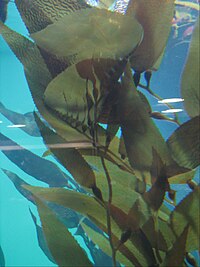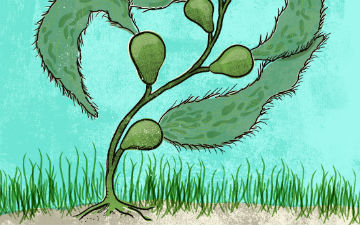| Giant kelp | |
|---|---|
 |
|
| Macrocystis pyrifera | |
| Scientific classification | |
| Kingdom: | Chromalveolata |
| Division: | Heterokontophyta |
| Class: | Phaeophyceae |
| Order: | Laminariales |
| Family: | Laminariaceae |
| Genus: | Macrocystis |
| Species: | M. pyrifera |
| Binomial name | |
| Macrocsytis pyrifera | |
| Synonyms | |
|
|
Macrocystis pyrifera, commonly known as Giant kelp or Giant bladder kelp, is a species of kelp (large brown algae), and one of four species in the genus Macrocystis. Giant kelp is common along the coast of the eastern Pacific Ocean, from Baja California north to southeast Alaska, and is also found in the southern oceans near South America, South Africa, and Australia. Individual algae may grow to more than 45 metres (148 ft) long at a rate of as much as 2 feet (61 cm) per day. Giant kelp grows in dense stands known as kelp forests, which are home to many marine animals that depend on the algae for food or shelter. Humans harvest kelp for its rich iodine, potassium, and other minerals, but the primary product obtained from giant kelp is alginate.
Description
M.pyrifera is the largest of all algae. The stage of the life cycle that is usually seen is the sporophyte, which is perennial and individuals persist for many years. Giant kelp receives its name from its incredible size. Individuals may grow to up to 50 metres (160 ft) long.[2] The stalks arise from a holdfast and branch three or four times from near the base. Blades develop at irregular intervals along the stipe, with a single pneumatocyst (gas bladder) at the base of each blade.[3]
A related and similar-looking, but smaller species, M.integrifolia, grows to only to 6 metres (20 ft) long. It is found on intertidal rocks or shallow subtidal rocks along the Pacific coast of North America (British Columbia to California) and South America.[4][5]
http://en.wikipedia.org/wiki/Giant_kelp




